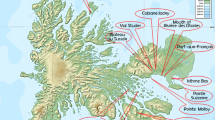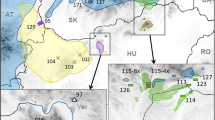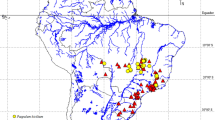Abstract
Members of the genus Sesleria are important vegetation elements and are regarded as diagnostic or constant species in many plant communities. However, their identification is often problematic due to their similar morphology and phenotypic plasticity. Although the genus has been studied by many specialists, numerous taxonomic problems remain unresolved. A controversial issue is the alleged presence of S. sadleriana and its hybrid with S. kalnikensis in Slovenia and NW Croatia. To resolve the situation, we used flow cytometry and determined the relative genome size in a large set of Sesleria samples, because this marker proved to be an effective tool in species identification in our previous Sesleria study. A total of 287 individuals from 24 Sesleria populations from NE Italy, Slovenia and NW Croatia were analysed in this study, and the results were compared with our previous dataset comprising 717 samples (representing 57 populations) of Sesleria species collected in other parts of Central Europe (Austria, Poland, Slovakia, Hungary, Romania). We have revealed that none of the studied populations from Slovenia or Croatia could be assigned to S. sadleriana or the hybrid S. kalnikensis × S. sadleriana. Of the 24 populations, 5 were identified as octoploid S. juncifolia, 3 as octoploid S. kalnikensis s.s., 11 as octoploid S. kalnikensis s.l., and 5 as an unknown tetraploid populations. The identity of S. kalnikensis s.l. and tetraploid populations requires further studies.




Similar content being viewed by others
References
Avdulov NP (1928) Sistematiceskaja kariologija semejstva Gramineae. Dnevn Vsesoyuzn Sezda Bot 1928:65–67 (in Russian)
Avdulov NP (1931) Kario-sistematiceskoje issledowanje semejstva zlakov. Trudi Prikl Bot Genet Selekts Suppl 44:1–428 (in Russian)
Bartha D, Király G, Schmidt D, Tiborcz V, Barina Z, Csiky J, Jakab G, Lesku B, Schmotzer A, Vidéki R, Vojtkó A, Zólyomi S (eds) (2015) Magyarország edényes növényfajainak elterjedési atlasza. Nyugat-magyarországi Egyetem Kiadó, Sopron
Bennett MD, Leitch IJ (2005) Nuclear DNA amounts in angiosperms: progress, problems and prospects. Ann Bot (Oxford) 95:45–90. https://doi.org/10.1093/aob/mci003
Budzáková M, Šibík J (2015) Diversity, variability and habitat characteristics of the communities dominated by Sesleria species (Poaceae) in the Western Carpathians. Pl Biosyst 150:1249–1260. https://doi.org/10.1080/11263504.2015.1019589
Budzáková M, Hodálová I, Mereďa P Jr, Somlyay L, Bisbing SM, Šibík J (2014) Karyological, morphological and ecological differentiation of Sesleria caerulea and S. tatrae in the Western Carpathians and adjacent regions. Preslia 86:245–277
Conert HJ (1992) Sesleria Scop. In: Hegi G (ed) Illustrierte Flora von Mitteleuropa, 1(3). Parey, Berlin, pp 473–486
Deyl M (1946) Study of the genus Sesleria. Opera Bot Čech 3:1–246
Deyl M (1978) Flora europaea. Notulae systematicae ad Floram Europaeam spectantes. No 20. Gramineae. (289) Sesleria Scop. Bot J Linn Soc 76:364
Deyl M (1980) Sesleria Scop. In: Tutin TG, Heywood VH, Burges NA, Moore DM, Valentine DH, Walters SM, Webb DA (eds) Flora Europaea 5 (Alismataceae to Orchidaceae). Cambridge University Press, Cambridge, pp 173–177
Di Pietro R (2007) Taxonomic features of Sesleria calabrica (Poaceae), a neglected species from southern Italy. Folia Geobot 42:289–313. https://doi.org/10.1007/BF02806468
Di Pietro R (2017) Sesleria Scop.—Sesleria. In: Pignatti S (ed) Flora d’Italia seconda, 1st edn. Edagricole, Bologna, pp 597–603
Di Pietro R, D’Amato G, Trombetta B (2008) Karyology and distribution of Sesleria tenuifolia complex in the Italian Peninsula. Nordic J Bot 23:615–623. https://doi.org/10.1111/j.1756-1051.2003.tb00442.x
Di Pietro R, Kuzmanović N, Iamonico D, Pignotti L, Barina Z, Lakušić D, Alegro A (2013) Typification of names in the Sesleria juncifolia species complex (Poaceae). Phytotaxa 152:18–32. https://doi.org/10.11646/phytotaxa.152.1.2
Doležel J, Greilhuber J, Suda J (2007) Estimation of nuclear DNA content in plants using flow cytometry. Nat Prot 2:2233–2244. https://doi.org/10.1038/nprot.2007.310
Domac R (2002) Flora Hrvatske. Školska knjiga, Zagreb
Fischer MA, Oswald K, Adler W (2008) Exkursionsflora für Österreich, Liechtenstein und Südtirol, 3rd edn. Biologiezentrum der Oberösterreichischen Landesmuseen, Linz
Greilhuber J, Doležel J, Lysák MA, Bennett MD (2005) The origin, evolution and proposed stabilization of the terms ‘Genome size’ and ‘C-value’ to describe nuclear DNA contents. Ann Bot (Oxford) 95:255–260. https://doi.org/10.1093/aob/mci019
Hodálová I, Mártonfiová L, Onete M, Kučera J, Mereďa P Jr (2018) [Reports]. In: Marhold K, Kučera J (eds) IAPT chromosome data 28. Taxon 67:1237, E9–E11. https://doi.org/10.12705/676.39
Ilijanić L, Topić J (2000) Poaceae. In: Nikolić T (ed) Flora Croatica. Index Florae Croaticae 3. Natura Croatica 9 (Suppl. 1). Hrvatski prirodoslovni muzej, Zagreb, pp 130–149
Janka V (1884) Plantae novae. Természetrajzi Füzetek 8:28–29
Jávorka S (1911) Egy fel nem ismert Sesleriánkról. Über eine verkannte Sesleria. Magyar Bot Lapok 10:311–314
Jogan N (1999) Poaceae (Gramineae)—Trave. In: Martinčič A, Wraber T, Jogan N, Ravnik V, Podobnik A, Turk B, Vreš B, Mala Flora Slovenije: ključ za določanje praprotnic in semenk, 3rd edn.Tehniška Založba Slovenije, Ljublijana, pp 711–813
Jogan N (2001a) Nomenclatural notes to the 3rd edition of Mala flora Slovenije (1999). Hladnikia 11:25–26
Jogan N (ed) (2001b) Gradivo za Atlas flore Slovenije. Materials for the Atlas Flora of Slovenia. Center za kartografijo favne in flore, Miklavž na Dravskem polju
Jogan N (2007) Poaceae (Gramineae) – Trave. In: Martinčič A, Wraber T, Jogan N, Podobnik A, Turk B, Vreš B, Ravnik V, Frajman B, Strgulc Krajšek S, Trčak B, Bačič T, Fischer MA, Eler K, Surina B, Mala flora Slovenije, 4th edn. Tehniška založba Slovenije, Ljubljana, pp 826–932
Jogan N (2014) Sesleria Scop.—Blaugras, Elfengras. In: Rottensteiner WK (ed) Exkursionsflora für Istrien. Naturwissenschaftlicher Verein fur Karnten, Gebunden, pp 744–745
Kliment J (1999) Komentovaný prehľad vyšších rastlín flóry Slovenska, uvádzaných v literatúre ako endemické taxóny 1, 2. Bull Slov Bot Spoločnost 21(Suppl 1):1–434
Kováts D (1984) Poaceae type specimens of Herbarium Carpato-Pannonicum in Budapest II. (Calamagrostis—Sesleria). Stud Bot Hung 17:61–68
Kožuharov S, Petrova A (1991) Chromosome numbers of Bulgarian angiosperms. Fitologija 39:72–77
Kuzmanović NV, Schönswetter P (2016) No confirmation for previously suggested presence of diploid cytotypes of Sesleria (Poaceae) on the Balkan Peninsula. Biologia 71:639–641. https://doi.org/10.1515/biolog-2016-0087
Kuzmanović N, Comanescu P, Frajman B, Lazarević M, Paun O, Schönswetter P, Lakušić D (2013) Genetic, cytological and morphological differentiation within the Balkan-Carpathian Sesleria rigida sensu Fl. Eur. (Poaceae): a taxonomically intricate tetraploid-octoploid complex. Taxon 62:458–472. https://doi.org/10.12705/623.13
Kuzmanović N, Lakušić D, Frajman B, Alegro A, Schönswetter P (2017) Phylogenetic relationships in Seslerieae (Poaceae) including resurrection of Psilathera and Sesleriella, two monotypic genera endemic to the Alps. Taxon 66:1349–1370. https://doi.org/10.12705/666.5
Lazarević M, Kuzmanović N, Lakušić D, Alegro A, Schönswetter P, Frajman B (2015) Patterns of cytotype distribution and genome size variation in the genus Sesleria Scop. (Poaceae). Bot J Linn Soc 179:126–143. https://doi.org/10.1111/boj.12306
Leitch IJ, Leitch AR (2013) Genome size diversity and evolution in land plants. In: Plant genome diversity, vol. 2. Springer, Vienna, pp 307–322
Lövkvist B, Hultgård UM (1999) Chromosome numbers in south Swedish vascular plants. Opera Bot 137:1–42
Lysák MA (1996) Taxonomie a chorologie českých a slovenských druhů rodu Sesleria. MSc Thesis, Palacký University, Olomouc
Lysák MA, Doležel J (1998) Estimation of nuclear DNA content in Sesleria (Poaceae). Caryologia 51:123–132. https://doi.org/10.1080/00087114.1998.10589127
Lysák MA, Číhalíková J, Doležel J (1997) Morphometric and karyological analysis of a population of Sesleria sadleriana Janka in the Biele Karpaty Mountains (Slovakia). Folia Geobot Phytotax 32:47–55. https://doi.org/10.1007/BF02803884
Mandák B, Trávníček P, Paštová L, Kořínková D (2012) Is hybridization involved in the evolution of the Chenopodium album aggregate? An analysis based on chromosome counts and genome size estimation. Flora 207:530–540. https://doi.org/10.1016/j.flora.2012.03.010
Martinčič A (1969) Poaceae (Gramineae)—Trave. In: Martinčič A, Sušnik F (eds) Mala Flora Slovenije. Cankarjeva založba, Ljublijana, pp 448–485
Melichárková A, Španiel S, Marhold K, Hurdu B-I, Drescher A, Zozomová-Lihová J (2019) Diversification and independent polyploid origins in the disjunct species Alyssum repens from the Southeastern Alps and the Carpathians. Amer J Bot 106:1499–1518. https://doi.org/10.1002/ajb2.1370
Mereďa P Jr, Majerová M, Somlyay L, Pekárik L, Hodálová I (2019) Genome size variation in the Western Carpathian Sesleria (Poaceae) species. Pl Syst Evol 305:845–864. https://doi.org/10.1007/s00606-019-01622-1
Petrova A (2000) Karyological study of some species of Sesleria (Poaceae) growing in Bulgaria. Bot Chron (Patras) 13:133–140
Pignatti S (1982) Flora d’Italia 3. Edagricole, Bologna
Quintanar A, Castroviejo S, Catalán P (2007) Phylogeny of tribe Aveneae (Pooideae, Poaceae) inferred from plastid trnT-F and nuclear ITS sequences. Amer J Bot 94:1554–1569. https://doi.org/10.3732/ajb.94.9.1554
Rychlewski J (1955) Studia cytologiczno-systematyczne nad Sesleria tatrae Deyl. Acta Soc Bot Polon 24:163–179
Rychlewski J (1958) Badania cytologiczno-embriologiczne nad Sesleria tatrae Deyl. Acta Biol Cracov, Ser Bot 1:103–113
Schneider J, Döring E, Hilu KW, Röser M (2009) Phylogenetic structure of the grass subfamily Pooideae based on comparison of plastid matK gene-3’trnK exon and nuclear ITS sequences. Taxon 58:405–424. https://doi.org/10.1002/tax.582008
Skokanová K, Šingliarová B, Kochjarová J, Paule J (2019) Nuclear ITS and AFLPs provide surprising implications for the taxonomy of Tephroseris longifolia agg. and the endemic status of T. longifolia subsp. moravica. Pl Syst Evol 305:865–884. https://doi.org/10.1007/s00606-019-01624-z
Šlenker M, Zozomová-Lihová J, Mandáková T, Kudoh H, Zhao Y, Soejima A, Yahara T, Skokanová K, Španiel S, Marhold K (2018) Morphology and genome size of the widespread weed Cardamine occulta: how it differs from cleistogamic C. kokaiensis and other closely related taxa in Europe and Asia. Bot J Linn Soc 187:456–482. https://doi.org/10.1093/botlinnean/boy030
Soó R (1973) A magyar flóra és vegetáció rendszertani-növényföldrajzi kézikönyve. 5. Akadémiai Kiadó, Budapest
Strgar V (1980) Sesleria na subpanonskem vegetacijskem območju severnovzhodne Slovenije in severozahodne Hrvaške. Biol Vestn 28:99–116
Strgar V (1981) Die Sippenstruktur von Sesleria auf der Balkanhalbinsel. Bot Jahrb Syst 102:215–224
Strgar V (1984) Sesleria Scop. In: Martinčič A, Sušnik F (eds) Mala flora Slovenije: praprotnice in semenke, 2nd edn. Državna založba Slovenije, Ljubljana, pp 715–718
Suda J, Krahulcová A, Trávníček P, Krahulec F (2006) Ploidy level versus DNA ploidy level: an appeal for consistent terminology. Taxon 55:447–450. https://doi.org/10.2307/25065591
Suda J, Trávníček B, Mandák B, Berchová-Bímová K (2010) Genome size as a marker for identifying the invasive alien taxa in Fallopia section Reynoutria. Preslia 82:97–106
Suffren P (1802) Principes de Botanique, suivis d´un Catalogue des plantes du Friaul et de la Carnia. Antonine Rosa, Venise
Tlili A, Gouja H, Vallès J, Garnatje T, Buhagiar J, Neffati M (2020) Chromosome number and genome size in Atriplex mollis from southern Tunisia and Atriplex lanfrancoi from Malta (Amaranthaceae). Pl Syst Evol 306:11. https://doi.org/10.1007/s00606-020-01643-1
Trávníček P, Ponert J, Urfus T, Jersáková J, Vrána J, Hřibová E, Doležel J, Suda J (2015) Challenges of flow-cytometric estimation of nuclear genome size in orchids, a plant group with both whole-genome and progressively partial endoreplication. Cytom A 87:958–966. https://doi.org/10.1002/cyto.a.22681
Trinajstić I (1995) Samoborsko gorje, a refuge of various floral elements between the Alps and the Dinaric mountains. Acta Bot Croat 54:47–62
Trinajstić I, Regula-Bevilacqua L, Cerovečki Z (2006) Fitocenološko-sintaksonomske značajke vrste Sesleria sadleriana Janka u Horvatskoj. Agron Glas 1(2006):3–12
Trombetta B, Granati A, D’Amato G, Sabina R, Martelli G, Di Pietro R (2005) Un approccio integrato (tassonomico, biosistematico e fitosociologico) allo studio del genere Sesleria Scop. nell’Appennino. Inform Bot Ital 37:58–59
Ujhelyi J (1959a) Révision des espèces du genre “Sesleria” en Italie. Webbia 14:597–614. https://doi.org/10.1080/00837792.1959.10669690
Ujhelyi J (1959b) Species Sesleriae generis novae. Feddes Repert 62:59–70. https://doi.org/10.1002/fedr.19590620108
Ujhelyi J (1960) Weitere Zytotaxonomische Beiträge zur Kenntnis der Gattung Sesleria. Bot Közlem 3–4:278–280
Ujhelyi J, Felföldy L (1948) Cyto-taxonomical studies of Sesleria sadleriana Janka and S. varia (Jacq.) Wettst. Arch Biol Hung 18:52–58
Zángheri P (1976) Flora Italica 1. CEDAM, Padova
Zimmermann A, Kniely G, Melzer H, Maurer W, Höllriegl R (1989) Atlas gefährdeter Farn- und Blütenpflanzen der Steiermark. Amt der Steiermärkischen Landesregierung, Graz
Zozomová-Lihová J, Melichárková A, Svitok M, Španiel S (2020) Pleistocene range disruption and postglacial expansion with secondary contacts explain the genetic and cytotype structure in the western Balkan endemic Alyssum austrodalmaticum (Brassicaceae). Pl Syst Evol 306:47. https://doi.org/10.1007/s00606-020-01677-5
Acknowledgements
We are grateful to Dominik Roman Letz for help with plant collection, to Ladislav Pekárik and Marek Šlenker (all Bratislava) for help with the statistical analyses. We thank the curators of the LJU, ZA, and ZAHO herbaria for allowing us to study the herbarium specimens. This study was supported by the Grant Agency of Ministry of Education of the Slovak Republic and Slovak Academy of Sciences VEGA (Grant No. 2/0131/16).
Funding
This study was funded by Vedecká Grantová Agentúra MŠVVaŠ SR a SAV (VEGA 2/0131/16) to Iva Hodálová.
Author information
Authors and Affiliations
Corresponding author
Ethics declarations
Conflict of interest
The authors declare that they have no conflict of interest.
Additional information
Handling Editor: Ivana Rešetnik.
Publisher's Note
Springer Nature remains neutral with regard to jurisdictional claims in published maps and institutional affiliations.
Contribution to “Plants of the Balkan Peninsula in Space and Time”.
Electronic supplementary material
Below is the link to the electronic supplementary material.
Information on Electronic Supplementary Materials
Information on Electronic Supplementary Materials
Online Resource 1. Regions in Slovenia and Croatia from where S. sadleriana or its hybrids/intermediate types with/to other Sesleria taxa have been reported, and classification of Sesleria sect. Sesleria populations from these regions according to relevant publications.
Online Resource 2. Mitotic chromosomes of Sesleria species.
Online Resource 3. Histograms of fuorescence intensity in simultaneous analyses of DAPI-stained nuclei isolated from several Sesleria individuals.
Online Resource 4. 2C relative genome sizes (in arbitrary units; a.u.) of the Central European representatives of the genus Sesleria.
Online Resource 5. Mean predicted values and 95% confidence intervals from linear mixed models for relative genome size of selected Sesleria species/populations.
Rights and permissions
About this article
Cite this article
Hodálová, I., Mártonfiová, L., Skokanová, K. et al. The utility of genome size in plant identification: a case study on Sesleria (Poaceae) from Croatia and Slovenia. Plant Syst Evol 306, 87 (2020). https://doi.org/10.1007/s00606-020-01715-2
Received:
Accepted:
Published:
DOI: https://doi.org/10.1007/s00606-020-01715-2




